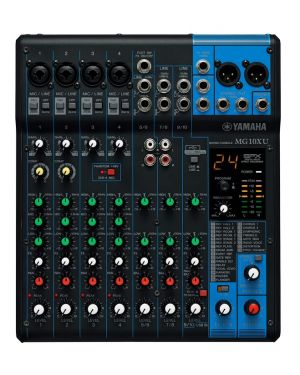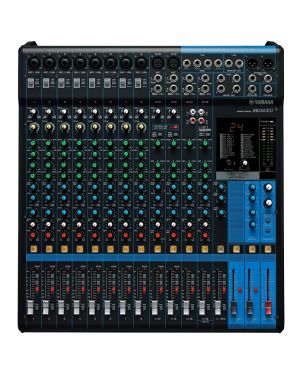Whether you're podcasting or streaming at home, building a project recording studio or mixing a live band, we've got a massive selection of Audio Mixing Desks to fit your requirements.
TRY BEFORE YOU BUY - MIXING DESKS IN-STORE NEAR YOU!
PMT stocks all the best audio mixer brands including Yamaha, QSC, Presonus, Allen & Heath, Mackie and Soundcraft and many more. Click & Collect from any PMT Store around the UK, or speak to our In-Store PA & Live Sound experts to find the right choice.
WHAT ARE MIXING DESKS USED FOR?
Mixing Desks are an ideal investment when you have multiple audio sources recording or capturing sounds simultaneously. For example, if you have 2 vocal microphones, a guitar, a keyboard and a drum kit on stage, you can feed each instrument into a channel on a Mixing Desk and individually control volume, EQ, Effects and more. With a mixer, you can tweak and optimise the sound of your inputs and outputs and prevent any mishaps whilst recording or playing live.
Most Mixing Desks fall under 3 categories:
ANALOGUE, DIGITAL, OR POWERED?
Analogue Mixing Desks are simple, straightforward audio mixers that don't use any digital processing or connectivity. These are perfect for connecting microphones or other instruments.
Digital Mixing Desks employ digital processing (DSP) or motorized faders and are commonplace for Studio Mixing Desks that interface with a PC or Mac. Many Digital Mixing Desks have USB, Firewire or Thunderbolt connections for simple connectivity and use with DAW Software.
'Powered' mixing desks provide an amplified power output, ideal for use with 'Passive' (or un-powered) PA Speakers. These may be a common feature of live sound desks if the venue does not have a dedicated PA Amplifier.
WHAT IS A CHANNEL ON A MIXING DESK?
A channel on a mixing desk represents one 'input'. For example, you can plug one microphone into Channel 1, a Keyboard into Channel 2, and a Guitar into channel 3. A single channel will often feature EQ Controls (to adjust Treble, Mid and Bass Frequencies), as well as Gain, Volume or Effect levels. Most mixers feature XLR and jack inputs for instruments with stereo for backing tracks and keyboards.
Smaller, compact mixers between 4-6 channels are suitable for solo musicians, podcasters or Twitch streaming. These usually have 1-2 microphone inputs, an aux input, and several stereo outputs to connect monitor speakers or an amplifier.
For larger installations and professional touring musicians, 24 and 32 channel mixing desks are available.
WHAT IS ROUTING ON A MIXING DESK?
Signal routing allows you to 'send' several channels on your mixer to a single 'Auxilary' channel. For example, you can combine two microphone inputs and route it to one Aux Channel, which has many benefits. You can apply the same level of effects to several inputs at once, which makes for a more cohesive sound and overall mix.
Whilst many mixers have built-in effects like Reverb or Delay, a mixer with FX routing allow you to 'send' your signal to an external Effects Processor, which is sent back to your mixing desk.

![Yamaha MG10XU USB Mixing Desk]() In Stock
In Stock![Yamaha MG16XU Mixing Desk]() In Stock
In Stock![Yamaha MGP32X 32 Channel Mixing Console]() In Stock
In Stock![Yamaha MG12XU 12 Channel Mixing Desk with USB]() In Stock
In Stock![Peavey Mixer Fx2 32]() In Stock
In Stock![Yamaha MGP24X 24 Channel Mixing Console]() In Stock
In Stock![HH Electronics HPX108 Speakers with Trumix MX2 Mixer]() In Stock
In Stock![Peavey XR S 8 Channel Powered Mixer]() In Stock
In Stock![Yamaha MG06X 6 Channel Mixing Desk with Effects]() In Stock
In Stock![Yamaha EMX7 Powered Analogue Mixer]() In Stock
In Stock![Yamaha MG10XUF 10-Channel USB Mixer]() In Stock
In Stock![Soundcraft Si Impact 40 Input Digital Mixer]() In Stock
In Stock![Dynacord Powermate 600 MkIII Powered Mixing Desk]() In Stock
In Stock![Allen & Heath SQ-6 96kHz Digital Mixing Desk]() In Stock
In Stock![Yamaha MG20XU Mixing Desk]() In Stock
In Stock![Yamaha MG16 Mixing Desk]() In Stock
In Stock![Dynacord PowerMate 1000 MkIII 10 Channel Compact Powered Mixer]() In Stock
In Stock![Yamaha MG12X CV Mixer]() In Stock
In Stock![Peavey Mixer Pv14 At Autotune]() In Stock
In Stock![Peavey Mixer Pv14 Bt Bluetooth]() In Stock
In Stock![Yamaha MG10X CV Mixing Console]() In Stock
In Stock![Peavey PV 10AT Compact 10 Channel Mixer]() In Stock
In Stock![Yamaha MG16X CV Mixing Console]() In Stock
In Stock![Yamaha MG12 Mixing Desk]() In Stock
In Stock






















